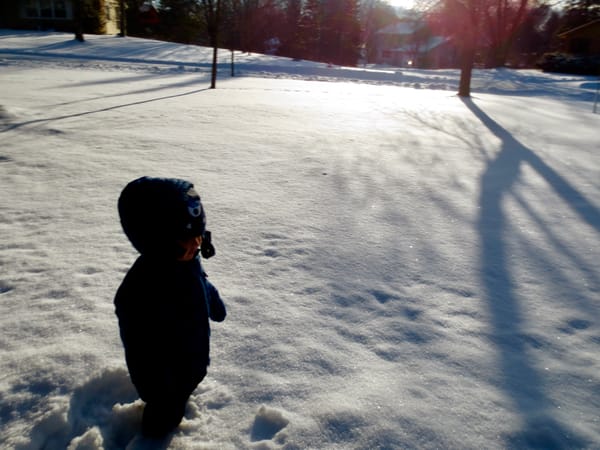Rekindling Imagination Amidst Brokenness
What children have to teach us about destruction and rebuilding

“Plant your sorrow in
the soil. Next year it will
grow into a set of oars.”
~Victoria Chang
There is a productive hum that develops in the best moments in a preschool classroom, when all of the children are engaged in busy collaborative creation, deeply working at their ideas, negotiations, and experimentation. This hum of activity isn’t free of friction or distress. In fact, one of the marks of growth, both in individual children and in the community of the classroom, is the extent to which children can manage and move through ruptures. The growing complexity that we see in their work over the course of a school year is due only in part to the development of their knowledge, thinking, and practical skills; their work also becomes more complex because of their emerging tolerance for the moments when things go awry and their capacity to find renewed creative opportunity in these moments.
Adults often think of children as uniquely creative. And, indeed, in many ways they are. Young children demonstrate much higher capacities for divergent thinking—the ability to consider a wide variety of possible ideas, no matter how unlikely or improbable. Divergent thinking is an essential component of creativity; in order to create something new, rather than to simply rehash and iterate upon versions of existing ideas, it is necessary to be able to see possibilities where others are only able to pivot within presumed constraints. The physician, Kamran Abbasi, in an introduction to the research on divergent thinking in children, notes,
“A longitudinal study of kindergarten children measured 98% of them at genius level in divergent thinking. Five years later, when they were aged 8 to 10 years, those at genius level had dropped to 50%. After another five years, the number of divergent thinking geniuses had fallen further still.”
To an extent, this evolution away from divergent thinking is a necessary feature of growing up. As the psychologist, Alison Gopnik, explains, the young child’s mind is unusually capable of attending to a much more diverse array of information than the adult mind, because the job of the child is to take in and make sense of all the stimulation that the world has to offer, whereas the job of the adult is more often to hone in on tasks and information with focus. There are also ways in which school and life experience chip away at divergent thinking by occupying us more and more with what the play researcher, Jill Vialet, terms “the tyranny of apparent purpose.”
Though the move away from divergent thinking as we grow is in many ways necessary, there are times, as Gopnik also points out, when adults would benefit from a little more openness to the wide lens of attention and possibility that fuels young children’s capacity for inventiveness. And, in a profound way, I think we are in a moment that demands this expansive form of thinking from all of us now. As the news seems filled each day with stories of destruction, we will need to rediscover our capacity, not only for resistance (something your children are also notoriously good at), but also for radical and improbable imagination.
The education researcher, Barbara Peterson, recently described this need to couple resistance with an embrace of imagination. She says,
“So what can we do? We build. We shift away from reform—away from tweaking broken systems—and instead direct our energy toward creating entirely new ones. And the beauty of this method is: we don’t have to start from scratch. We can draw from history.
One of the most effective nonviolent movements in modern times was Gandhi’s campaign for Indian independence. His success wasn’t built on protest or disruption alone. Gandhi believed civil disobedience was just one part of the work. It’s also critical to build what he called constructive programs—alternatives to the unjust systems he sought to replace.
These were the foundations of a new society, built within the shell of the old. Because resistance isn’t only about saying no. It’s about creating a future worth saying yes to.”
This is difficult for adults. We cling to completed structures and the clarity of the familiar. I suspect that part of what often challenges adults to think divergently and imaginatively—and often makes us more prone to linger in despair—is that we have less frequent experience navigating destruction. When so much seems to be crumbling around us, it’s easy to become mired in loss, as we adults easily find ourselves scrambling to hold shattered fragments together or resigned to mourning among the ruins. But an essential aspect of young children’s facility for creativity is their familiarity with destruction, and we can all learn from this now.

This is perhaps the feature of early childhood classroom life that adults often find the most uncomfortable. Many classroom rules are constructed by adults to limit destruction. Some of this, of course, is necessary, as we strive to keep small bodies safe from tumbling blocks, foster children’s awareness of the impact of their actions on others, and nurture their understanding of responsible resource use when they rapidly tear through reams of paper. But there is also a heightened discomfort with mess and uncertainty among adults. We are more accustomed to having control over our environment and we often feel a responsibility to maintain order and productivity. Children, by contrast, typically have very little control over their environment and are rarely motivated by order or productivity.
In a young child’s world, things are constantly falling apart. Blocks tumble, paint spills, the same scraped knee opens again and again with each fall. And, yet, they are also constantly building again, turning to a blank page, resuming the game and renegotiating the rules. Their exuberance, and at times their clumsiness, makes them more keenly familiar with fragility and more accustomed to navigating among and seeing the potential in brokenness.
As the educator and toy designer, Karen Hewitt, says,
“It is the moment of destruction, when stones tumble and blocks collide, when recognizable forms collapse and apparent chaos ensues, that allows children to refocus and become innovators again. This is also the moment that many adults prefer to forget, or even to eliminate.”
There is occasionally a gleeful quality to these moments of destruction among children, as an excited or overwhelmed child relishes the feeling of visceral power that can accompany intentionally demolishing something—the wide-eyed thrill of knocking a tall tower down and watching the pieces scatter. This might seem to valorize the “move fast and break things” understanding of creativity that has taken over so much of contemporary innovation culture and has now turned toward bigger and more vital social and political structures. After all, if children are more creative and are also more prone to breaking things, it may seem to follow that sweeping destruction is the key to renewed creativity.
However, as anyone who has spent significant time with young children knows, this form of gleeful destruction for its own sake, which we readily associate with children, is actually not how structures are most often toppled in the classroom. It is usually a fleeting phase, and it is also the hardest type of destruction to recover from, often muting creative energy, though learning to rebound from such moments is one of the most important lessons of childhood. There are other forms of destruction, though, that are more intentionally part of the creative process. Becoming fluent in these nuances is at the heart of a child’s work, and we could all benefit from becoming versed in this language now.
While it is true that children occasionally cause destruction purely for the thrill of surging adrenaline, this is most common among toddlers, who still reside in a largely sensory world, in which motion and noise hold their own fascination. Toddlers are also more adept at empathizing with the tears of their friends after a structure has collapsed or a toy has been broken than predicting those tears before they occur. As a result, this impulsive smashing diminishes fairly quickly, as children become more invested in sustaining their relationships and realizing their shared creative ideas. And this transition is where creativity among children really takes off.
The other types of destruction that children frequently confront are accidental destruction and destruction that is purposeful but intentionally regenerative. The first is a frequent occurrence among young children, who are sharing space and still learning to manage coordination and forethought. This can feel momentarily like the arbitrary, intentional destruction that fractures trust, but trust is more readily reestablished once it’s clear that the damage was unintentional. The second type of destruction—purposeful dismantling—usually occurs when children either have a clear idea in their imagination of what they want to create and decide that their current effort is not aligned with their imagination, or when a new idea emerges that a child or group of children determines is superior and warrants a clean slate.
In any instance of destruction and resuming creativity—whether intentional but unwelcome, accidental, or purposeful and consensual—two things are necessary for creativity to recover. Children must accept the loss of that which was destroyed, and they must find a spark of imagination that ignites a new way forward and renews their motivation. Children practice these skills constantly, because there is so much opportunity for working through the cycles of destruction and creation in their daily lives. And these are the skills we adults must relearn now, as we absorb loss and learn to reignite our own sense of imagination, despite the fear, sadness, and anger that destruction often provokes.
All loss involves reckoning with grief. Whether destruction is inflicted with malice or accidentally, and even when it is approached with intentionality and care, knowing we are making room for something new, it requires that we let go of what was. And letting go is rarely easy, regardless of the impetus. It is hardest when it involves a loss of trust as well as more material losses, and we are certainly in a period of deeply fractured trust. But, whatever the cause and however dire the ramifications, loss also always establishes new openings and asks us what we will do with the cracks of light that emerge.
The opportunity to reimagine that destruction presents doesn’t justify breaking things simply to experience the exhilaration of our own power, nor does it justify carelessness, particularly when either of these antecedents causes suffering. Children, gradually and appropriately, learn to avoid these forms of demolition and instead channel their creativity into more purposeful cycles of creation, disassembly, and renewed creation. They learn that it is sometimes beneficial to begin again with a clean sheet of paper or a pile of newly unassigned blocks.
But they also learn that there are ways of achieving this fresh start that minimize collateral damage and avoid causing pain to their peers. They learn how to persevere through the incidents of unintended or more hostile destruction when they do occur. They learn that, whatever the cause, there is always a way to come back together and begin again with renewed vision. And they are often uniquely able to see possibilities in that renewal.
I think we are faced now with a set of tasks very similar to the tasks of the classroom—to resist purposeless and power hungry destruction where we can; to recognize the suffering caused by reckless destruction and to do what we are able to prevent it or at least to staunch the bleeding and offer comfort when we cannot limit the wreckage; and to begin to reignite our imaginations and take on the work of envisioning new and better constructions and inspiring others to do the same.
In a recent commencement speech, the historian, David Blight, citing Frederick Douglas, describes this experience of seeing what’s possible within the wreckage of all that has been destroyed as “hopeful affliction.” He says,
“Listen to Frederick Douglas in February 1864…in a particularly bleak moment of the winter of the most enormous bloodletting of The Civil War—a dark moment. The former slave said, ‘The most hopeful fact of the hour is that we are now in a salutary school, a school of affliction.’”
Though we may not seek destruction, it is possible to find hope in affliction, because there are lessons to be learned from our grief and through our imagining of what might be built anew. But hope is only found in destruction when we are able to couple our grief with imagination—when we are able to move through our grief to conceive of something new and commit, together, to shaping it. We have to do this even as we walk among the scattered pieces of what once was and tend to those who are most directly harmed. This is what children learn about hope and creativity as the blocks tumble, paper tears, or they collide on the playground, and it is where we must anchor our own hope and our most thoughtful and sustained effort.
“We are now in a salutary school.”
What world would you imagine amidst the ruins? What would you rebuild and what would you create that has never been?
Wishing you care in the present moment and radical imagination for the future,
Alicia
A few things I found helpful and hopeful this week…
- A 7-year-old spoke out on behalf of libraries
- A teen spoke out to defend her trans competitor
- Disabled protesters courageously shut down the house advocating for their rights
- The Herculean Effort to Save the Smallest Sea Turtles
- Why Building Inspiring Alternatives Is Necessary
If you think someone else in your life might need some hope, please share. It’s always easier to hold onto hope when we’re not doing it alone.
And if you appreciated this post and are not already a subscriber, please consider subscribing to Notes on Hope.





